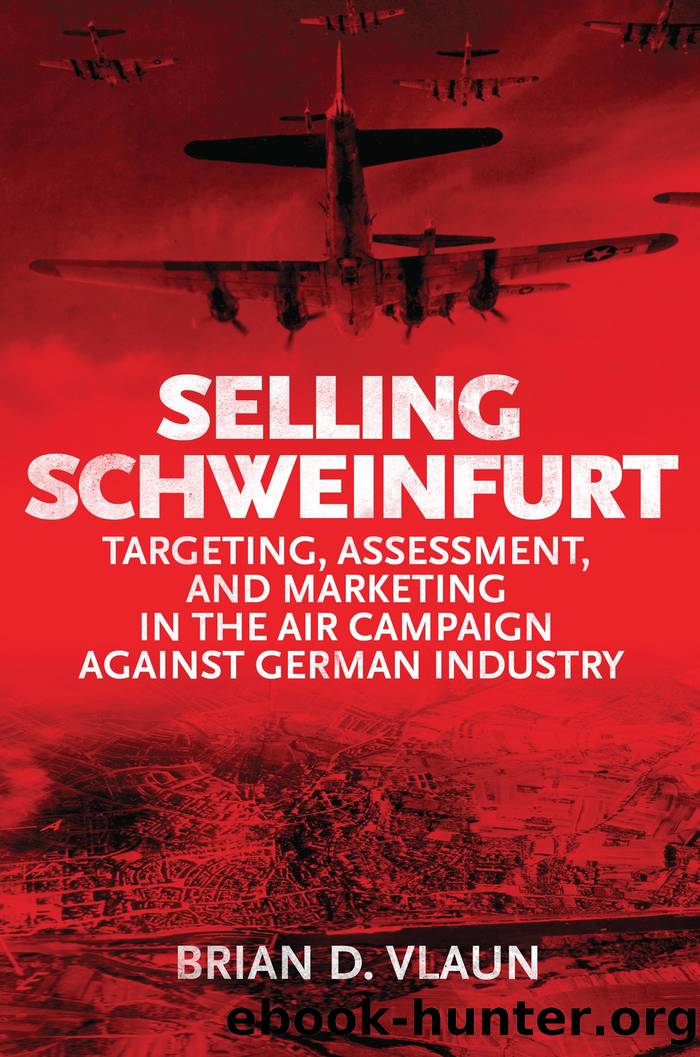Selling Schweinfurt by Brian D. Vlaun

Author:Brian D. Vlaun
Language: eng
Format: epub
Publisher: Naval Institute Press
Published: 2020-10-15T00:00:00+00:00
Photo 4-3. August 17 Schweinfurt Raid Approximate Bomb Plot.
Reprinted from Central Interpretation Unit, âInterpretation Report No. S.A. 466,â RAF Medmenham, 17 August 1943, AFHRA
Elsewhere in Washington that week, two air staff plans officers attended a peculiar meeting. Rather than rendezvous in their typical war department spaces, however, they convened privately at the office of Mr. Batt, who was continuing his leadership duties with both the War Production Board and SKF Industries. Batt argued that the ball-bearing industry in the United States grew limited in âcertain important articles ⦠due to the labor difficulties in the industry,â but that these articles could be purchased from Sweden, which âwould deny them to the enemy.â135 Further, Batt sought an arrangement for additional military aircraft able to transport the ball bearings out of Sweden. When the planners brought this information to their boss, Brigadier General Kuter, he replied skeptically, âIf there is a real requirement for these ball bearings or if it is proved that damage could be done to the enemy by our purchase rather than letting them become available to the enemy. [O]ne, two, or three C-47âs can and naturally will be made available for this purpose.â136 Battâs motives were anything but transparent, but Kuter was not going to take any chances that the Swedes were taking pressure off of Schweinfurt.
Economists from British RE8 continued their own trend of conservative estimates, and they pulled no punches as they countered the OSS and A-2 assessments with an even more pessimistic outlook: âThe attacks on the ballbearing plants at Schweinfurt caused relatively light damage. ⦠This amounts altogether to a loss of about 1 weekâs supply of total anti-friction bearing output available to Germany. ⦠Both plants will have been ready for re-attack immediately after the raid, since the reduction in the rate of output at each was very small.â137 They confidently concluded from the same source material that the raid accomplished negligible results. As they saw it, the raid had not been worth the lives of the many airmen who had perished or even the more fortunate fate of those who had parachuted into harvest wheat fieldsâprobably the only ones who were grateful the RAF had not followed up with a night raid.138
Hitlerâs Vengeance and the Blue Hour
âBomberâ Harris had not simply opted out of the AAFâs first attack on ballbearing plants. In fact, his Bomber Command launched its own massive raid under the lunar glow of 17â18 August 1943, and it did so en masse. However, Harris received a competing priority from an unusual targeting sourceâWinston Churchill himselfâand the highly secretive target had nothing to do with the Pointblank directive. The target was too challenging to attack even with the help of the RAFâs radio navigation (OBOE) and the bombersâ onboard radar (H2S). Each of these technological inventions warrants brief discussion.
OBOE used ground stations to transmit a signal that a single bomber could process and echo back to the ground; the system could achieve impressive accuracy of just a few hundred yards,
Download
This site does not store any files on its server. We only index and link to content provided by other sites. Please contact the content providers to delete copyright contents if any and email us, we'll remove relevant links or contents immediately.
| Africa | Americas |
| Arctic & Antarctica | Asia |
| Australia & Oceania | Europe |
| Middle East | Russia |
| United States | World |
| Ancient Civilizations | Military |
| Historical Study & Educational Resources |
The Light of Days by Judy Batalion(1067)
First Platoon: A Story of Modern War in the Age of Identity Dominance by Annie Jacobsen(904)
Stalin's War: A New History of World War II by Sean McMeekin(863)
The Pacific War 1941-1943 by James Holland(803)
Walk in My Combat Boots by James Patterson(766)
The American War in Afghanistan by Carter Malkasian(744)
Victory's Price (Star Wars) by Alexander Freed(735)
The Vietnam War: An Intimate History by Geoffrey C. Ward & Ken Burns(724)
Blood and Ruins: The Great Imperial War, 1931-1945 by Richard Overy(688)
Operation Pedestal by Max Hastings(683)
Concepts of Space by Jammer Max;(667)
Cold War (Alexander King Book 2) by Bradley Wright(663)
Extreme Fitness by Chris McNab(654)
The Madman Theory by Jim Sciutto(652)
Flying Tiger by Samson Jack(637)
World War II Infantry Fire Support Tactics by Gordon L. Rottman(613)
Pathfinders by AL-KHALILI JIM(611)
Panzerkrieg by Mike Syron(601)
Hitler’s Pre-Emptive War: The Battle for Norway, 1940 by Henrik O. Lunde(586)
